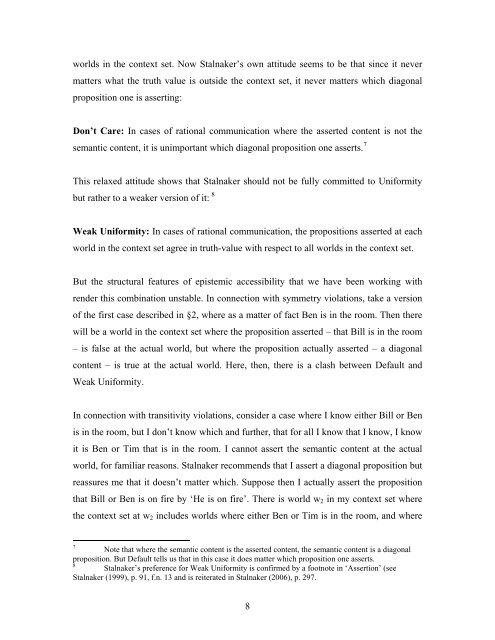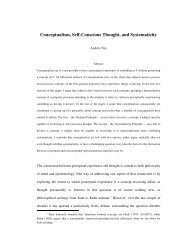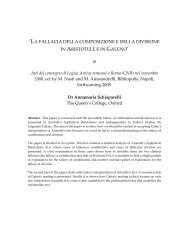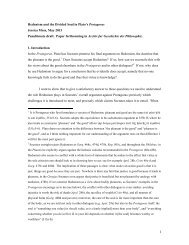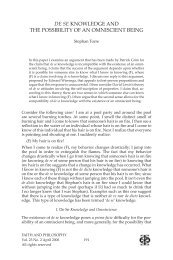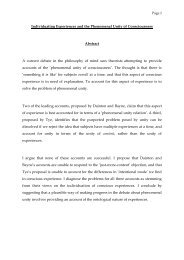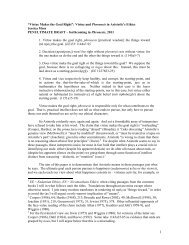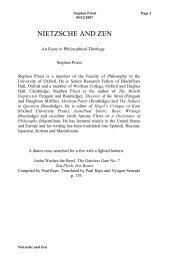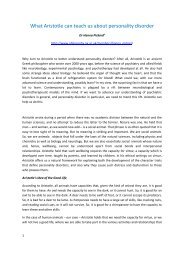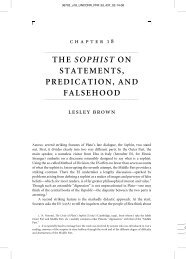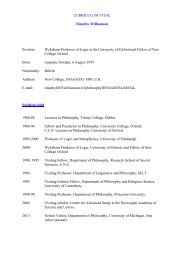In 'Assertion', Robert Stalnaker distinguishes between the sema
In 'Assertion', Robert Stalnaker distinguishes between the sema
In 'Assertion', Robert Stalnaker distinguishes between the sema
You also want an ePaper? Increase the reach of your titles
YUMPU automatically turns print PDFs into web optimized ePapers that Google loves.
worlds in <strong>the</strong> context set. Now <strong>Stalnaker</strong>’s own attitude seems to be that since it never<br />
matters what <strong>the</strong> truth value is outside <strong>the</strong> context set, it never matters which diagonal<br />
proposition one is asserting:<br />
Don’t Care: <strong>In</strong> cases of rational communication where <strong>the</strong> asserted content is not <strong>the</strong><br />
<strong>sema</strong>ntic content, it is unimportant which diagonal proposition one asserts. 7<br />
This relaxed attitude shows that <strong>Stalnaker</strong> should not be fully committed to Uniformity<br />
but ra<strong>the</strong>r to a weaker version of it: 8<br />
Weak Uniformity: <strong>In</strong> cases of rational communication, <strong>the</strong> propositions asserted at each<br />
world in <strong>the</strong> context set agree in truth-value with respect to all worlds in <strong>the</strong> context set.<br />
But <strong>the</strong> structural features of epistemic accessibility that we have been working with<br />
render this combination unstable. <strong>In</strong> connection with symmetry violations, take a version<br />
of <strong>the</strong> first case described in §2, where as a matter of fact Ben is in <strong>the</strong> room. Then <strong>the</strong>re<br />
will be a world in <strong>the</strong> context set where <strong>the</strong> proposition asserted – that Bill is in <strong>the</strong> room<br />
– is false at <strong>the</strong> actual world, but where <strong>the</strong> proposition actually asserted – a diagonal<br />
content – is true at <strong>the</strong> actual world. Here, <strong>the</strong>n, <strong>the</strong>re is a clash <strong>between</strong> Default and<br />
Weak Uniformity.<br />
<strong>In</strong> connection with transitivity violations, consider a case where I know ei<strong>the</strong>r Bill or Ben<br />
is in <strong>the</strong> room, but I don’t know which and fur<strong>the</strong>r, that for all I know that I know, I know<br />
it is Ben or Tim that is in <strong>the</strong> room. I cannot assert <strong>the</strong> <strong>sema</strong>ntic content at <strong>the</strong> actual<br />
world, for familiar reasons. <strong>Stalnaker</strong> recommends that I assert a diagonal proposition but<br />
reassures me that it doesn’t matter which. Suppose <strong>the</strong>n I actually assert <strong>the</strong> proposition<br />
that Bill or Ben is on fire by ‘He is on fire’. There is world w 2 in my context set where<br />
<strong>the</strong> context set at w 2 includes worlds where ei<strong>the</strong>r Ben or Tim is in <strong>the</strong> room, and where<br />
7<br />
Note that where <strong>the</strong> <strong>sema</strong>ntic content is <strong>the</strong> asserted content, <strong>the</strong> <strong>sema</strong>ntic content is a diagonal<br />
proposition. But Default tells us that in this case it does matter which proposition one asserts.<br />
8<br />
<strong>Stalnaker</strong>’s preference for Weak Uniformity is confirmed by a footnote in ‘Assertion’ (see<br />
<strong>Stalnaker</strong> (1999), p. 91, f.n. 13 and is reiterated in <strong>Stalnaker</strong> (2006), p. 297.<br />
8


